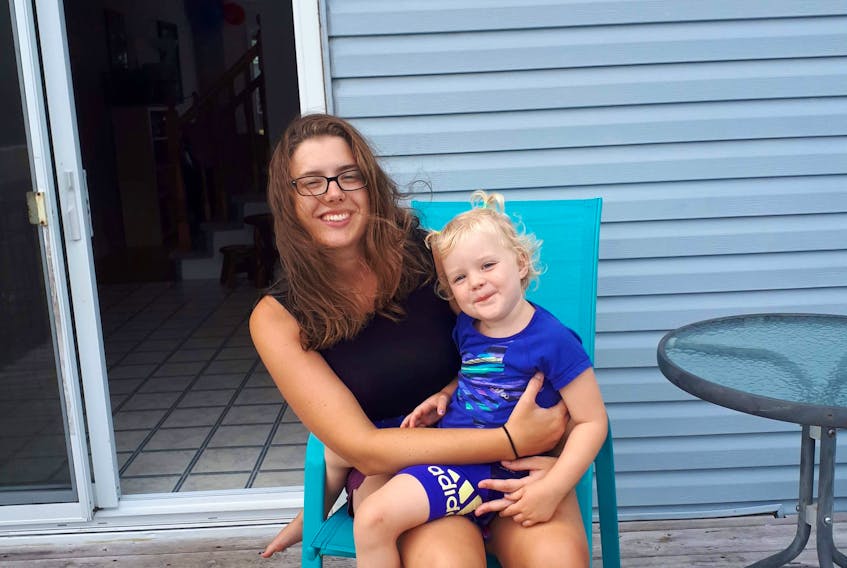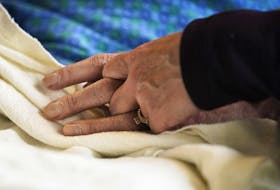It’s the height of summer and the sun is shining, the heat is blazing upwards of 35 degrees. The big picture windows at the front of the Francis house and glass patio doors to the back deck let natural light flood in.
It’s a bright, sunny day, but every lamp in every corner of the house is turned on.
Comfortable in her familiar surroundings, three-year-old Nora zips around the house without a care, climbing on the back of the sofa, climbing on her mom. She shows off her blue fingernail polish that matches her toes, her mom’s toes, and, coincidently, mine.
Dad tries to distract her with a blue Freezie, but the excitement of all the colour co-ordination revs her up even more. She’s as happy and excitable as most other three-year-olds.
But come twilight, it’s like an instant switch. While other kids will be playing and shrieking outside for another hour or so, Nora becomes uncomfortable, starts slowing down, curls up on her mom or dad’s lap.

That’s because Nora has a rare, inherited eye disease called Leber’s Congenital Amaurosis. It causes night blindness for Nora. It’s a condition with severe vision impairment and degenerative blindness that will get worse over time.
“It becomes obvious elsewhere, what she can’t see,” says Nora’s mother, Sitka Polk.
They were at a friend’s house the day before. The home had darker paint on the walls, not as many lamps, and it was a dark and gloomy afternoon. Nora struggled to find her way around.
“You have to plan around that,” says Polk. “We can accommodate her at home.”
Nora’s dad, Dave, recalls having family in town a few weeks earlier.
“We’re trying to figure out where to go eat without needing a head lamp for her, which is cumbersome.”
In restaurants with dim lighting, Nora can’t see her food. They finally decided on a rooftop patio, then his aunt and uncle had a hard time with the steep stairs.
“You really become aware of the light and dark, how dark restaurants really are for the vision impaired,” he says.
“This is more than, ‘oh well, no one can see in the dark.’ We want to be clear to people, it’s a serious thing, a serious vision impairment.”
Something wrong
When their second-born child was just five weeks old, Francis and his wife, Polk, were told their baby was blind.
“We were told to get ready for lifelong blindness. That was a bit of a nightmarish time,” says Francis.
Nora was born full-term. She had no health issues anyone was aware of, but in those first few weeks, her parents say they had an uneasy feeling.
“She wouldn’t look at you at all,” says Polk. “Nora was screaming because all she wanted to see was a light. That’s what was giving her visual stimulation, and nothing else.”
At five weeks old, Nora developed Nystagmus.

“Her eyes started moving up and down rapidly and we didn’t know what Nystagmus was,” says Polk.
That’s when they took her to the emergency at the IWK.
“We didn't know if she was seizuring; it’s rare and it was scary. Optimistically, we were thinking, we’ll go in here and the emerg doctor will tell us ‘Oh yes, this happens sometimes with new babies,’ but when we got there, they had no idea what it was. Our hearts were sinking every time we heard, ‘Oh that’s weird, we’ve never seen this before.’”
Within an hour, they were sent to neurology, where EEG results came back normal. They were then told it was Nystagmus, an eye condition where the eyes make repetitive, uncontrolled movements, and is associated with severe visual impairment.
“After some tests, the doctor said, ‘Let’s be clear. We’re talking about total blindness here',” says Francis.
“It’s a diagnosis no one expected.”
Francis remembers calling to tell family.
“It’s just out of leftfield. They thought we were joking.”
Puzzling improvement
Six months later, something surprising happened: Nora’s eyes started responding.
“We said no, we’re going crazy, she can’t really see, but it seems like she can,” says Francis. “So we brought her in (to see her eye specialist) and she had a test and they said, ‘Yeah, she can see’.”
Nora had started pointing at things. Tests showed she was almost on par with a child with normal vision. To her parents’ relief, the diagnosis of total blindness started to look more like delayed visual maturation. Nora’s eye structure looked healthy and pink.
But there was still the question of why Nora had Nystagmus. There was a whole list of things it could be, explains Polk.
“Eye conditions are complicated and can take years to diagnose.”
And for the next year, her vision got better.
But as Nora grew, darkness was still an issue. She needed bright light to see well. Polk did a lot of research on her own and suspected Nora had congenital stationary night blindness. The eye specialist agreed with her suspicions - everything lined up.
In June 2018, Nora was scheduled for an electroretinogram (ERG), which measures the electrical response of the light-sensitive cells in your eyes, to confirm those suspicions.
“The definitive test we were hoping, expecting, they would say it was just night blindness, and the specialist said ‘Nope, it’s LCA’,” says Francis. “It’s that one we said hopefully it’s not that, don’t even think that. So, we found out and it was like that nightmare hit again.”
Having vision improve is a hallmark of LCA-2, the type of genetic eye condition Nora was eventually diagnosed as having. Her eye structure looked healthy and pink because with LCA-2, the eye structure degenerates over time.
“We were almost at the point where it felt like, ‘Oh remember when we thought she was going to have blindness?’ Thinking we dodged the bullet. We thought, ‘OK, congenital stationary night blindness, it won’t get any worse than this’.”
Up until that test last year, her parents didn’t know Nora had a form of degenerative blindness that would get worse. Even her doctor was surprised how well she was doing, considering the diagnosis.
Nora sees well in bright light. She is not legally blind in a lab setting, when her eye exams are well lit.
But once it’s dark? She fumbles around, a completely different child.
Soon, they started to notice little changes. Nora was tilting her head and neck a lot, awkwardly changing her posture to improve her peripheral vision. They’ve started patching her stronger eye to strengthen the left eye to help correct some of her posture issues.
'Super rare'
Genetic testing confirmed the diagnosis, concluding Nora has an abnormality on the RPE65 gene.
“We’re both recessive carriers on that gene, we had to be or else we would have had a problem,” laughs Francis, sliding a glance to his wife.
He says question came up at meetings if there was any chance the couple were related. They are not; her family hails from California, his from Newfoundland. There are no visual impairments in either’s immediate family history. Their seven-year-old daughter, Celeste, has no vision or health issues at all.
Francis and Polk, by complete coincidence, are both carriers of a mutation on different genes (proving they weren’t related or the mutation would be on the same gene), each passing a copy to Nora.
They have a 50 per cent chance of their offspring being an unaffected carrier of LCA, a 25 per cent chance of offspring not being affected at all, and a 25 per cent chance of a child having LCA.
The type of LCA Nora has, LCA-2, is not associated with other health issues.

“It’s super rare,” says Sitka. She flips through a blue binder, filled with pages of medical notes.
“One in 50,000 have LCA. Of those, three to 16 per cent have LCA-2, or RPE65 that Nora has. The odds are super low. Statistically, there would be maybe 100 to 200 people in Canada living with this.”
There is no one else in the Maritimes with this particular type of LCA. Polk is part of a Facebook group for others with the disease. Recently, one Canadian woman from Toronto joined. She has a nine-year-old daughter with LCA-2 and told Polk in nine years, she has never met another person who has it.
Hope for improvement
The promising news is that LCA-2 has successfully been treated with a gene therapy called Luxturna, approved in the U.S., but not yet available in Canada.
Polk says their specialist is optimistic the drug will eventually be approved in Canada, and confident they can get Nora into treatment within the next couple of years, at least in a trial. In the U.S., Luxturna has a list price of $850,000.
“Now with this disorder, if she’s not treated by the time she is a teenager, she will lose most of her vision,” says Polk.
“We don’t suspect too much change while she is young. So, the sooner the better. You want it done while they’re young and their cells are still healthier. Adults just don’t have the same response. Luxturna really only shows optimal benefits in children.”
And it's given them hope.
“We want it. It’s there. It’s available. It’s not a complete cure but they are continuously improving it,” says Francis. “The good cells go in and take over the bad cells
For now, it’s a waiting game - waiting for a change in little Nora’s vision, or for treatment to be approved in Canada, whichever happens first.
“I want to advocate treatment into Canada,” says Francis. “I want to make people aware that they are curing blindness in the U.S.”
Apart from patching her strong eye and adapting their lifestyle and environment, there is no other treatment.
Waiting game
Meanwhile, the family has been investing in a lot of lamps. Polk removes light fixtures to expose light bulbs to make them brighter.
“It’s not fancy but it does the trick.”
Nora sleeps with a lamp on so she’s not scared if she wakes up at night. She can’t see what’s in the room, or adjust her eyes to the darkness, but she can see the light.
When she comes from playing outside into a brightly-lit house, she wonders why her dad’s in the dark alone.
“That’s a slap in the heart,” says Francis. “It takes a good 10 minutes to adjust her eyes from daylight.”
The disease has rendered Nora accident-prone. One day, she ran into a side table and split her lip. A lamp now stands where the table was.
Another day, she was crawling around in the bathroom and ran into the toilet, banging her teeth hard enough they turned grey for six months.
“That’s a big yucky feeling when your kid runs face-long into a black metal chair because you left it out,” says Francis.
While night blindness is her biggest issue right now, there will be eventual progressive vision loss.
“From the people I’ve spoken to in groups, the most common time that they really start losing their vision drastically, from whatever vision they had to start, some poorer vision than Nora, since she’s on the higher end of vision than a lot of people who have this, but by teenagehood they start to lose rapidly,” says Polk.
Once Nora reaches school-age, she’ll have more challenges. Polk is trying to get a head start on learning so Nora can focus on her surroundings at school. At three-and-a-half, she’s already printing letters and numbers, she enjoys writing song lyrics with her dad, and can draw a pretty mean dinosaur.
“She’ll have support at school and may need help in dark halls,” says Polk. “But once she knows her surroundings, she does very well. She’s good at advocating for herself, she lets people know. She’s not the shy kid.”









